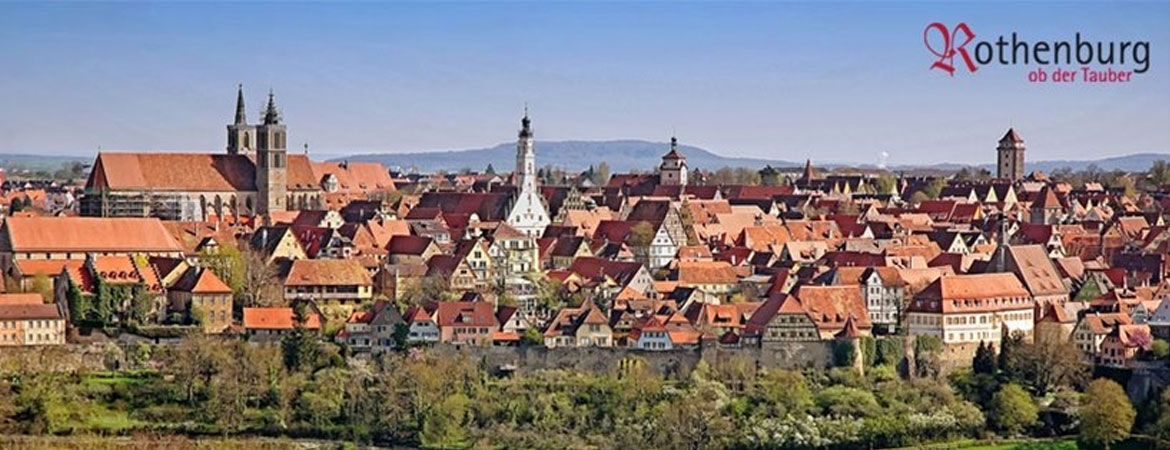
The Importance
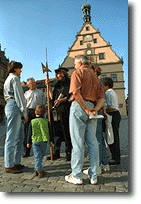 In the years before the dawn of the 20th century, the night watchman was one of many citizens of Rothenburg responsible for the safety of the inhabitants of this walled, fortified city. Even though the citizens who slept soundly at night in their beds trusted him to keep the streets inside the high stone walls safe, his status was less than honorable. His pay was low and his job was a dishonorable one. Only the gravedigger and the executioner were lower. His job was dangerous, because he had to guard the city at night like a policeman.
In the years before the dawn of the 20th century, the night watchman was one of many citizens of Rothenburg responsible for the safety of the inhabitants of this walled, fortified city. Even though the citizens who slept soundly at night in their beds trusted him to keep the streets inside the high stone walls safe, his status was less than honorable. His pay was low and his job was a dishonorable one. Only the gravedigger and the executioner were lower. His job was dangerous, because he had to guard the city at night like a policeman.
The good citizens went to bed early. The people that he met on the streets were the drunks and the thieves. To protect himself and to show his authority he carried an intimidating weapon called a hellebarde.
The Night Watchman gathers his followers in the Market Square in the heart of historic Rothenburg ob der Tauber, with the Councilor Tavern in the background.
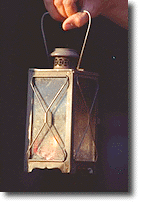
The night watchman made his rounds from nine in the evening until three in the morning, relying on the town hall clock to tell him when to sing his "Hour Song," which reminded the people who slumbered safe in their houses that he was still alive and taking care of them.
The night watchmans horn, carried on a chain around his neck, warned the citizens of fire--the worst possible disaster that could strike a city in the days before fire hydrants. Keeping watch over the streets of the inner city, lighting the lanterns and announcing the hours in the still of the night were the duties of Rothenburg[+]s night watchman. There were six of these men patrolling the city up to the year 1920.
Rothenburg ob der Tauber
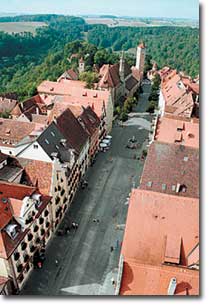 As a "Free Imperial City," or a state within a state, Rothenburg ob der Tauber enjoyed a status that allowed its citizens to enjoy a finer standard of life than people who lived in surrounding towns. Some of the tools of their daily lives can still be seen throughout the city, like the "measuring sticks" on the side of the town hall on the Herrngasse.
As a "Free Imperial City," or a state within a state, Rothenburg ob der Tauber enjoyed a status that allowed its citizens to enjoy a finer standard of life than people who lived in surrounding towns. Some of the tools of their daily lives can still be seen throughout the city, like the "measuring sticks" on the side of the town hall on the Herrngasse.
Because people in those days couldn't read or write, the symbols were useful in promoting commerce in this busy, prosperous city. Citizens used the symbol of "rute," to measure the length of a field or longer distance. A "rute" is 3.93 meters in length, or nearly 13 feet. The measuring device called a "shoe" is 30.2 centimeters, or about the length of an average male foot, and the "elle," used to measure cloth or textiles measures 59 centimeters in length, or about two feet.
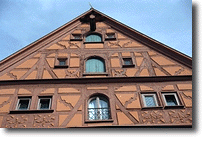 A common feature of Rothenburg and nearly every other city of its age are the doors and pulley systems mounted high up near the peak of the roof. On top of the houses, on the front side, is a beam reaching into the street. Inside of that beam is a metal wheel and under it a small wooden door or doors. The pulley was mainly used for bringing up large amounts of food, stored in the roof of the house where it was dry and away from the dirty and wet streets and the rats.
A common feature of Rothenburg and nearly every other city of its age are the doors and pulley systems mounted high up near the peak of the roof. On top of the houses, on the front side, is a beam reaching into the street. Inside of that beam is a metal wheel and under it a small wooden door or doors. The pulley was mainly used for bringing up large amounts of food, stored in the roof of the house where it was dry and away from the dirty and wet streets and the rats.
Each citizen was required by law to store grain to last a whole year for his family, to survive the time of a siege by forces hostile to Rothenburg. While fresh meat itself was available for all, poor people couldn't afford to store meat because it had to be salted in order to preserve it. Salt was very valuable and expensive, and because of this it was used as a second currency. It was called the "white gold." The word "salary" still shows how close salt and money was connected.
When Kings Came to Visit
 The "5th Avenue" of Rothenburg ob der Tauber is a street named "Herrngasse." Here and around the market square was where the rich patricians, the noble and the senators lived. The houses are especially large and show the prosperity of the town from the 14th to the 17th centuries. What was a visit from one of these royal "tourists" like?
The "5th Avenue" of Rothenburg ob der Tauber is a street named "Herrngasse." Here and around the market square was where the rich patricians, the noble and the senators lived. The houses are especially large and show the prosperity of the town from the 14th to the 17th centuries. What was a visit from one of these royal "tourists" like?
Because Rothenburg was a rich town, the rulers of the empire liked to come and visit. When a king came to town it was a big honor for the host family, but it was also very expensive for the whole city. When a king traveled he didn't come alone, he came with a crowd of about 200 people who all expected the best wine and food. Such a visit could last a week and none of the guests paid a penny.
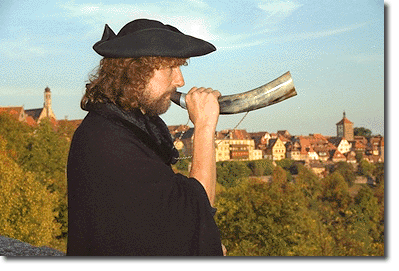
Even more expensive was the requirement to satisfy the royal guest with gifts, and he always preferred gold or money. If he was satisfied with his visit he would grant a new right or privilege to the town. These rights included being able to print our own money, having our own court system and the right to sell our products to new markets.
Rothenburg ob der Tauber was anything but "romantic" in the old days. Filth from thousands of geese, ducks, chickens, goats, horses and pigs filled the streets. People emptied their chamber pots directly into the street, calling out only a brief warning of "watch out" before they threw the night's accumulation into the street below. In the summertime it stank so bad in the city that the rich people left and lived out on the countryside, leaving those who were less fortunate behind to deal with an even larger problem. Worse than the stench and the swarms of flies were the thousands of rats who were attracted by the unsanitary conditions. The rats carried a flea that in turn carried a disease that came to be known as the "Black Plague," which eventually killed more than a third of Europe's population. Because of this and other problems there were no "Good Old Days" in Rothenburg and other cities across Europe.
Keeping Enemies Outside
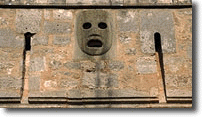 It's written in the Bible, "It is easier for a camel to walk through an eye of the needle than for a rich man to get into heaven." Here in Rothenburg we have the real eye of the needle, made for the residents of the city who had missed the closing of the town gates at night.
It's written in the Bible, "It is easier for a camel to walk through an eye of the needle than for a rich man to get into heaven." Here in Rothenburg we have the real eye of the needle, made for the residents of the city who had missed the closing of the town gates at night.
One hour before the gates were closed at twilight, the bells of the town were rung to call the citizens back home. After that hour, the gatekeepers shut the gates until the next morning for security reasons. If a citizen arrived at the gate after curfew he had only one chance to get inside where it was safe and that was through the eye of the needle.
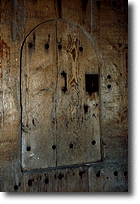 The "Got Pitch" mask on the Burgtor, one of the six entrance gates to Rothenburg. A mix of hot oil, tar and other boiling liquid poured on your head, if you had the courage to try and enter the city as an uninvited guest, truly was "Bad Luck" and would likely kill the trespasser. Slits for the drawbridge can be seen on either side of the mask.
The "Got Pitch" mask on the Burgtor, one of the six entrance gates to Rothenburg. A mix of hot oil, tar and other boiling liquid poured on your head, if you had the courage to try and enter the city as an uninvited guest, truly was "Bad Luck" and would likely kill the trespasser. Slits for the drawbridge can be seen on either side of the mask.
The Thirty Years War and the Fall of Rothenburg
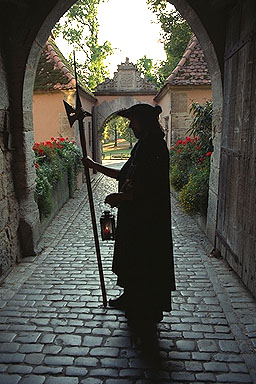 Seit der Stauferburg im 12. Jhd. bis zum großen 30-jährigen Krieg von 1618 bis 1648 wurde Rothenburg nicht von Feindeshand besiegt.
Seit der Stauferburg im 12. Jhd. bis zum großen 30-jährigen Krieg von 1618 bis 1648 wurde Rothenburg nicht von Feindeshand besiegt.
The city stood as an impenetrable fortress for centuries. From the time of the first Imperial Castle in 1142 to the siege of 1631, the city prospered and became what visitors today see as a crown jewel on the landscape. This changed during the Thirty Years War, which started in 1618 as a dispute between the Catholics and the Protestants.
At the end of October in 1631, General Tilly of the Imperial Catholic Army was searching for a winter quarter for his men. Rothenburg was the next, largest town and Tilly sent a mounted messenger to the city to tell the inhabitants to prepare for their arrival. This was horrifying news to the citizens of Rothenburg, because there were about 5,500 people living inside the walls and Tilly's army numbered 40,000. These were not the demanding royal guests of the past, but mercenaries who were paid for a certain time to kill and plunder. Worst of all they were Catholics, while Rothenburg was Lutheran Protestant. A majority of the town's senators decided to defend the city. The gates were shut, the drawbridges pulled up and the weapons were distributed. The citizens were counting on time being on their side. When a town was under siege the enemy needed a lot of time to break through the thick walls. Rothenburg was prepared to withstand months of siege, because of the law of all citizens having to keep a certain amount of food in their attic. The town waited.
Tilly's forces arrived and the General was furious to find only closed gates and loaded weapons bearing down on his tired, hungry troops. The battle began, hastened to a disastrous finish for Rothenburg's citizen army. A lucky shot from the attacking army hit their main storehouse of gunpowder, which was located in a tower on the exterior wall. The tower was blown to bits taking all the gunpowder with it. With a huge gaping hole in the wall and with no means to fight the citizens surrendered.
Tilly's troops took the city and without mercy took their revenge on the townspeople for the 300 soldiers they had lost in the battle. They left three months later; leaving behind an empty town that had been stripped of its riches, the citizens hungry and defeated.
In 1634 the Black Plague came to town and took what Tilly's men hadn't, 40% of the survivors lost their lives. For another 14 years both Protestants and Catholics ransacked it until the war ended in 1648. The city was a shell of its former self. It had never been burned or destroyed, but its people were exhausted. Rothenburg had none of its former power, no future and no money. The town fell asleep for 250 years and this is the reason why the city is so well preserved. You can visit what is virtually an outdoor museum of life in the time before the 17th century because of the poverty and despair that followed the Thirty Years War.
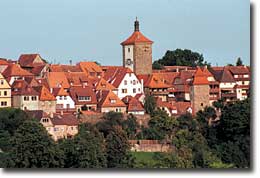
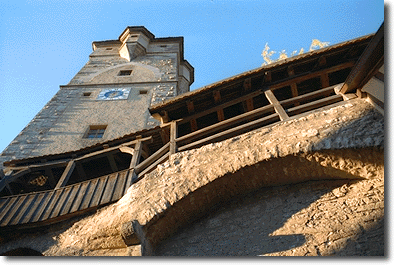
Rothenburg Wakes Up
It was the 1880s and Europe was entering the Age of Romance. German Painters discovered this sleeping town and through their work, the rest of the world discovered this perfectly preserved example of life in a time long since passed. The rest of Europe had modernized while Rothenburg slept.
With gathering speed Rothenburg was brought back to life by the work of these artists and those who followed. Tourists came to see this wonder of the early ages and by the beginning of the 1900s the tourism trade had become a real factor in the rebirth of Rothenburg. At this time, new laws were put into place prohibiting the citizens from making any changes to their houses or other structures, which guaranteed the sanctity of the inner city.
Then in March of 1945, a disaster of a proportion equal to the invasion of General Tilly's army occurred. On Easter, a German general and his troops left battered Nurnberg for Rothenburg. Together with some Nazi soldiers who were already stationed here, the general gave the order that the town should be defended to the last man. Two days later, on March 31st, 16 planes dropped their bombs on Rothenburg. The bombing of the town killed 39 people and destroyed 306 houses, six public buildings, nine of the town's ancient towers and more than 2,000 feet of the historic wall. War had returned with a vengeance to this fortified city.
But unlike 300 years ago, the city was saved by another warrior. Deputy Secretary of State General John McCloy, who was familiar with the historic importance and beauty of Rothenburg, sent word through the local commander, General Jacob L. Devers, that the city would be spared further bombing if the citizens could guarantee that it would not be used as a base for further resistance. With the war all but over, the citizens agreed and the town was spared. The German troops surrendered on the 17th of April and a few hours later, the city was again occupied by foreign troops--this time troops bearing the American flag. General John McCloy was awarded the "Honorable Protectorate of Rothenburg" in November, 1948.
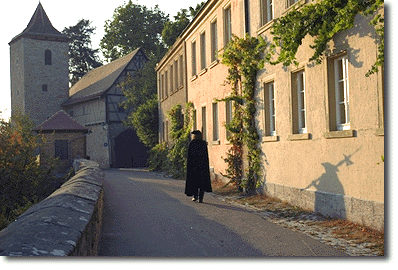
Take a walk back in time with the night watchman of Rothenburg ob der Tauber. Guided one-hour English language tours daily from April to Christmas beginning at 8 p.m. at the Market Square near the town hall. For information contact Hans Georg Baumgartner.
